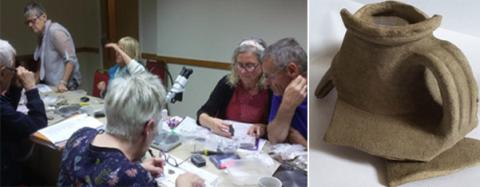Pottery Group

Part of The Artefacts and Archives Research Groups
Pottery is an important type of evidence because it survives in the soil for thousands of years. Even when pottery is broken into tiny pieces called sherds, it can still tell us something about the past. Pottery is an important tool in dating contexts in an excavation and helping to inform an understanding of the people who occupied an archaeological site.Pottery has two attributes that lend it great potential to inform the study of human activity in the past. The material a pot is made from, known to specialists as the fabric, consists of clay and inclusions that can be identified to locate the site at which a pot was made, as well as indicate methods of manufacture and date. The overall shape of a pot, together with the character of component parts such as rims and handles, and the technique and style of decoration, can be studied as the form. This can indicate when and how a pot was made and used, as well as serving to define cultural affinities.
Artefact analysis is a very important part of the post-excavation process that must be carried out before a site report can be written. It can also be a fun social activity and is a way to learn more about archaeological artefacts. We run two groups analysing pottery with one group focusing on Roman pottery and one on medieval pottery and post-medieval pottery.
Prior experience is not necessary, just a keen interest to learn about archaeological finds processing. We are also keen to expand the groups and would welcome anyone with or without experience, but with the enthusiasm to help build a picture of Surrey’s past. We meet on a Wednesday night at West Horsley Village Hall and/or on alternate Sundays at Abinger Research Centre. We are also keen to encourage people who would be interested in helping to clean and mark finds on excavations.
For further information please contact Lyn Spencer – lyn-spencer16@sky.com
